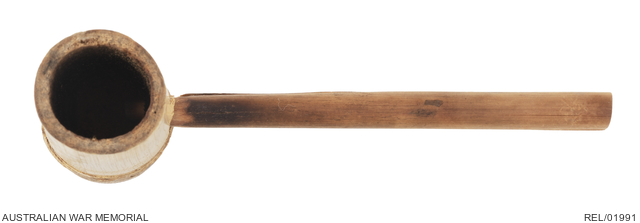| Place | Asia: Borneo, Sarawak, Kuching |
|---|---|
| Accession Number | REL/01991 |
| Collection type | Heraldry |
| Object type | Heraldry |
| Physical description | Bamboo |
| Maker |
Unknown |
| Place made | Borneo: Sarawak, Kuching, Lintang |
| Date made | c 1943 |
| Conflict |
Second World War, 1939-1945 |
| Source credit to | This item has been digitised with funding provided by Commonwealth Government. |
Prisoners' improvised smoking pipe, Lintang Barracks, Kuching, Borneo





Improvised pipe made entirely from bamboo. The bowl is a naturally hollowed out section of bamboo cut at one of the nodes. The stem is a smaller length of bamboo which makes use of the hollow nature of bamboo to form a natural bore. The stem is pushed into the bowl throught a hole drilled into the bowl. The effect is somewhat like a corncob pipe. The bowl is lightly traced with burnt tobacco.
This pipe has an improvised Military History Field Team sticker (a cut down gummed address label) around the bowl upon which is written '23'. It is also accompanied by a manilla Military History Field Team tag.
This collection of pipes (REL/01988 - REL/01995) was collected by the Military History Section Field Team attached to 9th Australian Division Headquarters. Writing on 25 September 1945 to John Treloar, Director of the Australian War Memorial, and describing their activities at the Kuching POW camp, an unidentified officer wrote:
'With regard to the relics, before the Australian officers left on the morning of 13 Sep, I got them to make a selection of personal relics for the AWM. These included improvised comforts, home-made pipes, etc, some of them with a story attached. I left these at the office of the Barracks pending spraying with disinfectant, informing the staff what they were and placing a big notice on top of the box stating that the contents were relics required by the AWM and were not to be touched. You can imagine my feeling on calling back for them to find that a newly-arrived officer had assumed it was rubbish left by the Japs and had had the lot burned. However we were able to duplicate most of the items from other Australian Officers huts.'